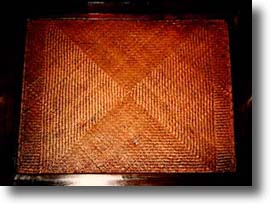 Soft, woven seats were traditional to Ming and early Qing furniture, although the use of hard seat panels is occasionally noted in early examples. Aside from its pliable support, the airiness of the woven bed frame was especially comfortable during the hot summer seasons. With regard to chairs, the customary use of woven seats gives way to increasing use of hard-panel seats during the 18th and 19th centuries, and old soft seats were also occasionally replaced with maintenance-free hard panels during this period.
Soft, woven seats were traditional to Ming and early Qing furniture, although the use of hard seat panels is occasionally noted in early examples. Aside from its pliable support, the airiness of the woven bed frame was especially comfortable during the hot summer seasons. With regard to chairs, the customary use of woven seats gives way to increasing use of hard-panel seats during the 18th and 19th centuries, and old soft seats were also occasionally replaced with maintenance-free hard panels during this period.
 Seat weaving was a specialized tradition, and itinerant specialists facilitated their frequent repair and renewal. Soft seats were produced in several traditional styles. Occasionally, processed animal tendons were used to weave an extremely pliant matting. Woven-rope and leather-strip seats were common to folding stools and folding chairs. More commonly, an underwebbing of twisted palm fiber was woven through the holes in the seat frame, after which, split cane was woven directly on top.
Seat weaving was a specialized tradition, and itinerant specialists facilitated their frequent repair and renewal. Soft seats were produced in several traditional styles. Occasionally, processed animal tendons were used to weave an extremely pliant matting. Woven-rope and leather-strip seats were common to folding stools and folding chairs. More commonly, an underwebbing of twisted palm fiber was woven through the holes in the seat frame, after which, split cane was woven directly on top.
The craft of weaving cane has all but disappeared. Modern recaning continues the underwebbing technique, however, the finely woven mat has been replaced by sheet matting that is cut to size and simply pinned into the holes with softwood wedges. The fiber and cane, having been soaked for several hours before weaving, dries to a taught, yet elastic seat panel.
Extract from:
Evarts, Curtis. C. L. Ma Collection: Traditional Furniture from the Greater Shanxi Region, 1999.
